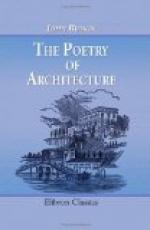206. Secondly. In the choice and design of his ornaments, the architect should endeavor to be grotesque rather than graceful (though little bits of soft flower-work here and there will relieve the eye): but he must not imagine he can be grotesque by carving faces with holes for eyes and knobs for noses; on the contrary, whenever he mimics grotesque life, there should be wit and humor in every feature, fun and frolic in every attitude; every distortion should be anatomical, and every monster a studied combination. This is a question, however, relating more nearly to Gothic architecture and therefore we shall not enter into it at present.[41]
[Footnote 41: [See Stones of Venice, vol. III. chap. iii.]]
207. Thirdly. The gables must on no account be jagged into a succession of right angles, as if people were to be perpetually engaged in trotting up one side and down the other. This custom, though sanctioned by authority, has very little apology to offer for itself, based on any principle of composition. In street effect indeed it is occasionally useful; and where the verticals below are unbroken by ornament, may be used even in the detached Elizabethan, but not when decoration has been permitted below. They should then be carried up in curved lines, alternating with two angles, or three at the most, without pinnacles or hipknobs. A hollow parapet is far better than a battlement, in the intermediate spaces; the latter indeed is never allowable, except when the building has some appearance of being intended for defense, and therefore is generally barbarous in the villa; while the parapet admits of great variety of effect.
208. Lastly. Though the grotesque of Elizabethan architecture is adapted for wood country, the grotesque of the clipped garden, which frequently accompanies it, is not. The custom of clipping trees into fantastic forms is always to be reprehended: first, because it never can produce the true grotesque, for the material is not passive, and, therefore, a perpetual sense of restraint is induced, while the great principle of the grotesque is action; again, because we have a distinct perception of two natures, the one neutralizing the other; for the vegetable organization is too palpable to let the animal form suggest its true idea; again, because the great beauty of all foliage is the energy of life and action, of which it loses the appearance by formal clipping; and again, because the hands of the gardener will never produce anything really spirited or graceful. Much, however, need not be said on this subject; for the taste of the public does not now prompt them to such fettering of fair freedom, and we should be as sorry to see the characteristic vestiges of it, which still remain in a few gardens, lost altogether, as to see the thing again becoming common.




